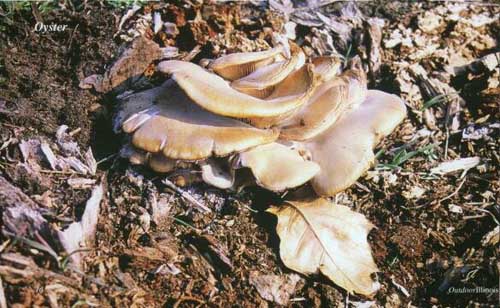 |
Home | Search | Browse | About IPO | Staff | Links |
 |
Home | Search | Browse | About IPO | Staff | Links |
|
Full Fungi
Forage the field for three of the best edible wild fall mushrooms. STORY BY KATHY ANDREWS Brilliant scarlet and gold leaves float downward, washing the forest floor in color. The annual cycle of food storage for the tree is coming to an end, only to bring a new supply of food to another group of organisms. Amid the leaves lie the decomposers—organisms breaking down plant and animal material and returning nutrients to the soil. Fungi, commonly called mushrooms and toadstools, are spore-bearing organisms that obtain energy from decomposing dead, and sometimes living, plant and animal material. Of the estimated 10,000 species of fungi in the United States, approximately 250 species are edible and another 250 poisonous. The palatability of the vast majority remains unknown. Three of the most common, edible fall mushrooms in Illinois are the oyster, hen-of-the-woods and giant puffball. The oyster mushroom grows on stumps, logs and rotten wood and can be found throughout Illinois most of the year. Caps of the oyster may be white, gray or yellow-gray and reach widths of 10 inches. Oyster mushrooms get their name from their appearance, not their flavor. Of the most common oyster mushrooms, the leaf and late oyster mushrooms are edible; however, the bitter oyster mushroom must be avoided. Because of its growth form, the oyster mushroom is easily cultivated and has become a popular addition to the produce section of many grocery stores. To prepare oyster mushrooms, soak them in salted water, rinse to remove bugs, then dip in beaten egg, roll in cracker crumbs and fry. The gray-brown hen-of-the-woods mushroom is highly prized and also found statewide. This fungus grows in clumps of fan-shaped caps that may be up to three and one-fourth inches wide. Clusters may grow singly or in groups, usually in hardwood forests, but occasionally with pine trees. Caps toughen

16 OutdoorIllinois
with age and become less desirable. When cooking hen-of-the-woods, simmer the freshest portions in salted water until tender. Serve as a vegetable with a cream sauce or chill and slice for use on a salad. The giant puff ball may be nearly 20 inches wide. The thin, white-brown outer layer of this fungi flakes off as it reaches maturity, exposing a white spore case. In contrast, the poisonous false puffball has a tough outer skin and dark spore case. Puffballs may be found growing singly or in a scattered arrangement in pastures, open spaces within woodlands, along roadsides and near stables. This common and widely distributed mushroom may be found in the late summer and fall. Other edible puffballs include the vase, spiny, gem, pear, pasture and sculptured giant. Puffballs are especially delicious when the tough outer rind is removed, and the meat is sliced into strips, dipped in egg and bread crumbs and fried in olive oil to a golden brown. Toxins found in fungi are categorized by the part of the body they affect. Cellular toxins are the most serious, followed by nerve poisons. Most toxins are considered gastrointestinal irritants. Some fungi, including certain species of the commonly sought spring morel, contain toxins that react with alcohol. Diners are advised to refrain from alcoholic beverages before, during and after a meal of these delicacies. The primary rule of fungi consumption is to be conservative. Do not eat a species you are not familiar with or have not positively identified. Never eat any wild fungi raw.
|
|
State Library |